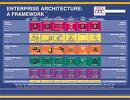Why Zachman's Framework
 Why Zachman's Framework. Information system becomes the most interesting asset for the enterprise these days. It's for this reason they conduct some ways to build or even engineering their information to get it much more effectiveness and efficient. The Zachman Framework™ is a schema - the intersection between two historical classifications that have been in use for literally thousands of years. The first is the fundamentals of communication found in the primitive interrogatives: What, How, When, Who, Where, and Why. It is the integration of answers to these questions that enables the comprehensive, composite description of complex ideas. The second is derived from reification, the transformation of an abstract idea into an instantiation that was initially postulated by ancient Greek philosophers and is labeled in The Zachman Framework™: Identification, Definition, Representation, Specification, Configuration and Instantiation.
Why Zachman's Framework. Information system becomes the most interesting asset for the enterprise these days. It's for this reason they conduct some ways to build or even engineering their information to get it much more effectiveness and efficient. The Zachman Framework™ is a schema - the intersection between two historical classifications that have been in use for literally thousands of years. The first is the fundamentals of communication found in the primitive interrogatives: What, How, When, Who, Where, and Why. It is the integration of answers to these questions that enables the comprehensive, composite description of complex ideas. The second is derived from reification, the transformation of an abstract idea into an instantiation that was initially postulated by ancient Greek philosophers and is labeled in The Zachman Framework™: Identification, Definition, Representation, Specification, Configuration and Instantiation.
Since The Zachman Framework™ classification was observed empirically in the structure of the descriptive representations (the architecture) of buildings, airplanes and other complex industrial products, there is substantial evidence to establish that The Zachman Framework™ is the fundamental structure for Enterprise Architecture and thereby yields the total set of descriptive representations relevant for describing an Enterprise.
The Zachman Framework™ typically is depicted as a bounded 6 x 6 "matrix" with the Communication Interrogatives as Columns and the Reification Transformations as Rows. The Framework classifications are represented by the Cells, that is, the intersection between the Interrogatives and the Transformations. This matrix would necessarily constitute the total set of descriptive representations that are relevant for describing something... anything: in particular an enterprise. For getting more understandable, it maybe we can try to practice it analysis our enterprise with framework of Zachman.

